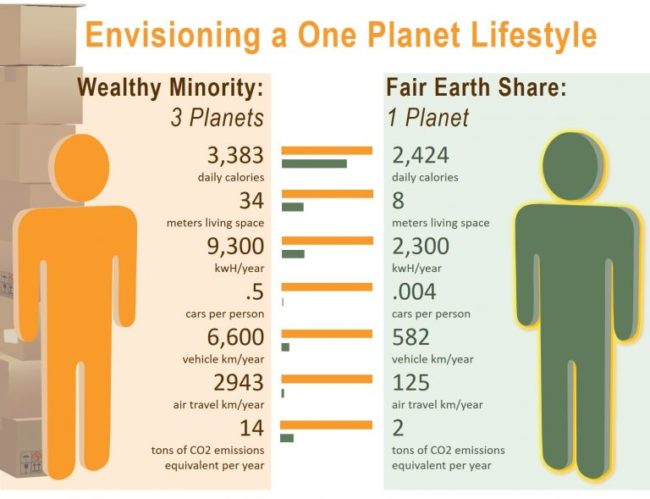Erik Assadourian responds to David Roberts’ Self-Censorship on Overpopulation. This article is cross-published by the Worldwatch Institute and Resilience.org.
Reading David Roberts’ recent explanation of why he never writes on overpopulation, I felt compelled to reply. While Roberts made a set of superficially convincing arguments, ultimately he’s wrong not to focus directly on the population pressures we’re facing. Not confronting population head-on is like looking out the window of a plane and realizing you’re about to crash but refusing to tell the other passengers about the impending crash. Instead you spend your remaining moments convincing people that it’s “empowering” to wear their seat belts. That it’s a good for their health to put their laptops away and hold their head between their legs. Sure, you’ll convince some—and those you do convince might be better off—but you’ll convince far fewer as the sense of urgency is gone.
Reducing the global population is essential in addressing humanity’s impact on the planet—along with reducing overall consumption (affluence) and the use of unsustainable technologies (all variables in the I = PAT equation). And after the missteps of the Sierra Club and some governments, Roberts can be excused for why he feels it may be smarter to simply address the P in the equation indirectly by focusing on women empowerment and providing good access to family planning (and I would add providing comprehensive sexuality education to all children, as Mona Kaidbey and Robert Engelman and discuss in EarthEd: Rethinking Education on a Changing Planet). But that won’t be enough.
Stabilizing population is urgent. The goal should not simply be to nudge along a little less growth so population stabilizes at 9 billion rather than 9.5 or 10 billion. Instead, we need to make a long term plan to get population back to a manageable range. How far to scale population back, as noted 10 years ago by Roberts in another essay on why he doesn’t talk about population, “is up for debate, but probably a lot.” Some, including Paul Ehrlich, have suggested the ideal population range is around 1-3 billion, depending on how badly we have damaged the Earth’s systems and how much we want to consume moving forward. If Roberts is serious when he says he wants poor countries to be less poor “than their forebearers” then that means the Affluence variable in the I = PAT equation will increase. Yes, affluence elsewhere must shrink in accordance (and I wholeheartedly agree that wealth inequities need to be grappled with as does consumerism more broadly), but our population—particularly the 2-3 billion of us in the global consumer class—is completely overwhelming Earth’s systems.
One-Planet Living
In Is Sustainability Still Possible?, Jennie Moore and William Rees explored what a one-planet lifestyle would look like (in a world with 7 billion not 9.5 billion) and their analysis shows that if we lived within Earth’s limits, gone would be the days of driving personal vehicles, flying, eating meat, living in large homes, and essentially the entire consumer society that we know today. Frankly, that’s fine with me, considering the ecological, social and health costs of modern society—but most will not accept that. And considering that—and that policymakers and economists and even most environmentalists still believe further economic growth is possible and even beneficial—it’s increasingly hard to imagine any scenario other than a horrifying ecological collapse in our future.

That is another reason why we should prioritize population degrowth. Every million people not born is a million not to die when climate change brings about terrible flooding, droughts, disasters and famines it will in the increasingly near future. And please don’t take this to the absurd extreme of ‘well, let’s just stop reproducing altogether and then there’ll be no suffering.’ I’m not saying people should have no children at all (here’s another Tucker Carlson video for you to enjoy, this one with the founder of the Voluntary Human Extinction Movement).
But people should have far fewer kids—particularly in overdeveloped countries like the United States. I personally chose to have one child, even though both my wife and I would like to have a second. But I deemed it morally irresponsible, or in the words of bioethicist Travis Rieder, not ‘honorable’ to have a second, particularly knowing what’s in store for our kids in the coming century, and knowing that by living in the United States, I am a ravenous consumer no matter how hard I try to be otherwise.
Historical Efforts
Roberts also selectively focuses on history to better make his point—providing examples of the Sierra Club brouhaha but not the work of all the population organizations that helped shift population trends in a positive direction. And while there have certainly been tragic missteps—such as India’s efforts at forced sterilization—there have been unqualified successes. In his book Countdown, Alan Weissman describes the amazing case study of Iran, which through a focused campaign, reduced population growth dramatically. Yes, the primary tactics were to provide free family planning and education, which I don’t think anyone will disagree are very smart tactics, but the government was clear in its goal and the urgency—and also supplemented its efforts with social marketing to create a smaller “normal” family size, including advertisements on TV, banners, and billboards explaining that “One is good. Two is enough.” Similar successes can be seen in the efforts of the Population Media Center that uses soap operas to shift norms around population size.
While I don’t know if the numbers were or could ever be estimated, efforts like Iran’s and PMC’s, like Stephanie Mills committing so publicly to never have children at the height of her reproductive years, and Paul Ehrlich capturing the public’s attention with his warnings about the population bomb, all of these helped focus our collective attention on population issues in the 1960’s and 70’s and certainly helped slow population growth.
Ultimately, Ehrlich, with as much criticism as he receives, was not wrong about the population bomb. His warnings and the efforts they helped trigger—along with the Green Revolution—allowed us to extend the fuse. But in all those years, the fissile material has also been building, and when the bomb finally explodes, the shockwaves will be felt around the world. In fact, even Norman Borlaug, the father of the Green Revolution warned, “Unless progress with agricultural yields remains very strong,” which Borlaug noted cannot continue indefinitely unless we cut down our forests, which he implored us not to do, “the next century will experience sheer human misery that, on a numerical scale, will exceed the worst of everything that has come before.”


On Immigration
As for immigrants—sure it probably wasn’t the best idea for Professor Phil Cafaro to go on Tucker Carlson’s show to support anti-immigrant sentiments, but Cafaro’s point is valid, even if uncomfortable and confusing for progressives. Until America has a one-planet footprint, all new immigrants are going to increase global impacts because they’ll consume more in the US than in their home countries. (This even suggests all adoption ideally should be domestic, which opens a-whole-nother can of worms!)
That’s not to say we should ban immigration or foreign adoption, but it means we should have a clear plan around immigration (along with one on reducing American consumption) and we should offset immigration by reductions in births of Americans (easier done if we have a population goal in mind for the United States). This offset is essentially what’s happening in European countries that have smaller than replacement rate birthrates—but the problem there is that this cultivates anti-immigrant sentiments as white European populations darken. With America at least, we have always been an immigrant nation so theoretically we could adapt, though obviously the current administration and its supporters are fomenting the same fears and biases that Americans have shown since its early days, as waves of immigrants from Ireland, Southern Europe, China, and Mexico started arriving.
Setting Goals
Is it so scary or morally fraught to start advocating for a smaller global population—or at the very least start talking openly about population challenges? Is it impossible to imagine nurturing a one-child family size norm in the US and Europe (where each child’s impact is many times greater than a child’s in a developing country)? One is good. Two is enough. Three is too many.
As Roberts notes, momentum is already bringing us toward smaller family sizes—but that same momentum is also bringing us toward higher consumption rates. Some smart social marketing and celebrity modeling could bring us toward reductions in population (as well as consumption) quicker. Breaking the myth that sole children are spoiled and lonely—as Bill McKibben did in his great book Maybe One—would be a good place to start. As would showing the economic and environmental benefits of having one child. And so would making it cool to have one child. Perhaps that’s the marketing slogan we use: “It’s Hip to Have One.”
And let developing countries shape their own population targets so as to avoid the obvious criticisms of imperialism (maybe it’s even time for a Framework Convention on Population Growth to go along with the Framework Convention on Climate Change—so all countries can feel ownership in this effort). But clearly, population stabilization is as important in developing countries—not because of the immediate effects on human impact (I), but because as Earth systems finally break down after the decades of abuse we’ve delivered, people are going to retreat from their flooding towns, their drought stricken lands, their war-torn regions, and they’re going to have to go somewhere. And then the right-wing extremists will say “we told you so,” waving their copies of Camp of Saints in their hands as they do, and be perfectly poised to take over more government institutions—and that may be the population crisis’ scariest outcome of all.
Erik Assadourian is a Senior Fellow at the Worldwatch Institute and a sustainability researcher who is primarily focused on rooting out the plague of consumerism and overconsumption, but recognizes that population is also a major threat to human civilization and the thriving of the biosphere.
The MAHB Blog is a venture of the Millennium Alliance for Humanity and the Biosphere. Questions should be directed to joan@mahbonline.org
MAHB Blog: https://mahb.stanford.edu/blog/must-talk-about-population/
The views and opinions expressed through the MAHB Website are those of the contributing authors and do not necessarily reflect an official position of the MAHB. The MAHB aims to share a range of perspectives and welcomes the discussions that they prompt.
